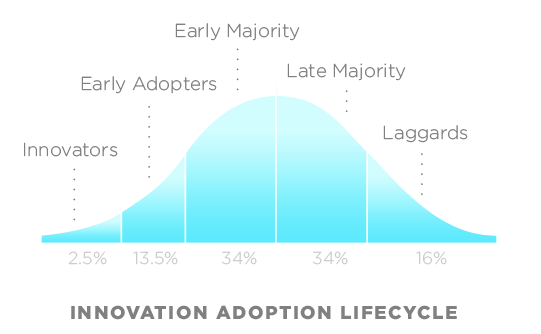Focus on Customers Who Will Come Back
By: SEER Interactive

I recently finished reading Simon Sinek’s “Start With Why” and wanted to share how to apply some of the concepts he discusses directly to customer experience for your business.


First, you need to be familiar with the “law of diffusion of innovation” which states “if you want to achieve mass-market success or mass-market acceptance of an idea, you cannot have it until you achieve this tipping point between 15 and 18 percent market penetration and then the system tips.” Watch Sinek’s TED talk to learn more. I’ll wait while you go watch.
You can see this concept laid out clearly on this bell curve chart:

What do companies do when faced with the challenge of needing to appeal to 18%+ of the mass market?
We generally see companies go right after the middle of the market—some portion of that 68% of early and late majorities. They try and appeal to everyone. They pour money into a sales department that isn’t focused on the right goals, pushing for large quantities of leads without bothering to check whether or not leads are converting, or whether or not those customers come back to buy more or tell a friend. And eventually, these companies fail.
It’s never easy to go after smaller growth
It’s hard to ignore the masses, especially if they’re somewhat interested in what you have to sell. It’s understandable—you want to make a sale and you want to believe that if people are somewhat interested, then you can convince them to be completely interested once they buy from you. But generally you can’t convince people to be completely interested—they convince themselves of it. Their friends can do it, but you probably can’t.
Related Article: Applying Political Terms to Marketing Segmentation
So these people buy your product once and they’re somewhat interested, but soon they forget about it and they don’t come back. This starts to happen a lot. Now things are getting harder. You’re reaching a lot of people who are somewhat interested and who buy your product once but they don’t come back and they don’t tell their friends. You’re pouring all of your energy and resources into capturing these people and they’re not even the people you really want.
Focus on the first 15% and the rest will follow
When someone who is part of the masses approaches you and is somewhat interested, let them take a look around, but don’t focus on them. Don’t change your product to please them, because now you know it’s pretty likely they won’t come back anyways. Focus on the people who already understand what you’re about because they’re about it, too. You’ll know these people when you see them; for Apple, they’re the folks that stand in line for hours to get a new iPhone. Pay attention to people’s behavior towards your brand. When they give you feedback, listen to them. When they share your product with their friends, thank them.
This sounds easy, but it’s not, and it’s why a lot of companies ignore the concept completely. It’s hard to say “Sorry, I am not going to focus my time on you because you’re not my core customer.” When you stick your flag in the ground to stand for something, it’s natural for a lot of people to be turned off. To complain. To walk away. Your job is to let them and to be ok with it. The people who are left, who still say yes, are the ones you want in the end.
Be honest with your customers
All of what is shared here must start with what Sinek shares in his TED talk and book. You won’t even be able to connect with the early adopters if you can’t clearly define this for yourself. I’ll wait now while you go watch for real this time 😉
Related Article: Is Customer Loyalty the Same as Retention?
Once you know what you stand for, don’t be stingy in sharing this with people, even if it turns them away from you. Don’t send out a fleet of salespeople to capture the most possible leads just because. Smart companies like Aha! are moving away from traditional sales teams completely and are just focusing on customer success. They know what they’re about, it’s easy for others to understand it and whether they’re about it too, so the only thing left to do is delight them with excellent and honest customer service.
Understand who is worth your time
Invest time in analyzing the buying patterns of your customers. Who are your repeat customers? What do they tend to do on your site? Optimize those channels and pathways and make sure you’re providing them with a consistent and exciting experience. Think With Google can help you figure this out if you’re just getting started.

Start a referral program. Assign a value for when a customer refers a friend – reward them for it and keep track of it. How do you measure a quality referral? Are two referrals from one customer more or less valuable than a second purchase? Understanding these metrics for your business will allow you to make smarter and more targeted decisions for your brand.
Be patient
It can be challenging to trust in a process that is generally more of a long-term investment. Take the time to do this work at the start so you’re not struggling down the road to capture the people who are already out there waiting to say “yes.”
This article was originally published by SEER Interactive
Published: March 6, 2015
2292 Views
2292 Views














